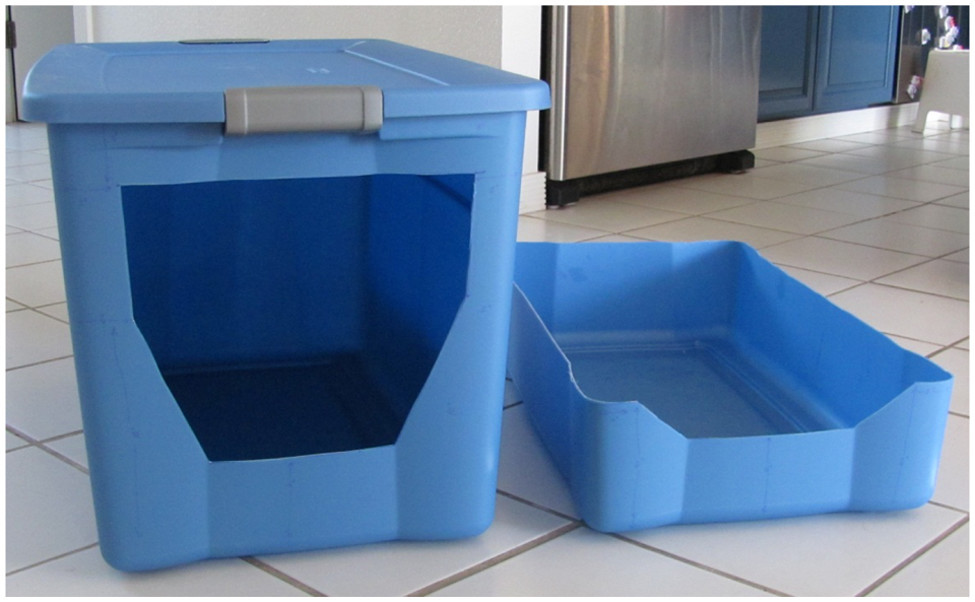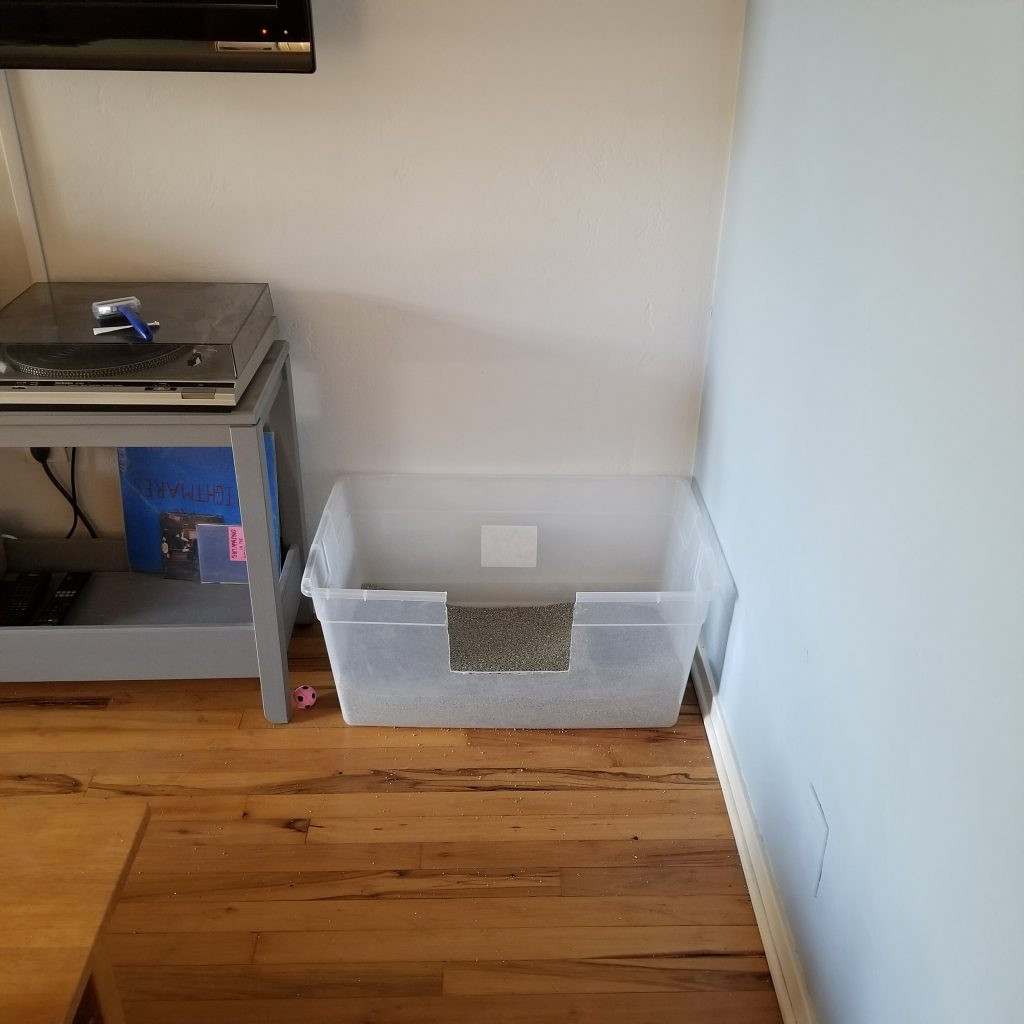Covered litter boxes, also known as hooded litter boxes, are a common sight in many cat households. They promise to contain odors and litter scatter, offering a seemingly cleaner and more private bathroom experience for our feline friends. But are covered litter boxes truly beneficial for cats? For a long time, conventional wisdom among cat experts suggested that cats dislike these enclosed spaces. However, a 2013 study presented a different perspective, indicating that cats might not have a strong preference between covered and uncovered litter boxes under specific conditions.
As a Certified Cat Behavior Consultant, I’ve always been cautious about recommending covered litter boxes. The aforementioned 2013 research, conducted by Dr. Emma Grigg, a respected colleague, prompted me to take a closer look at the data and consider the nuances often missed in general recommendations. This article will delve into this study, explore the reasons behind the initial hesitation towards covered litter boxes, and provide a balanced view to help you make informed decisions about your cat’s litter box setup. We’ll examine why interpreting scientific papers requires careful consideration and why looking at research results within a broader context is crucial for responsible cat ownership.
Understanding the 2013 Litter Box Study Methodology
The groundbreaking 2013 study, titled “Litter box preference in domestic cats: covered versus uncovered,” investigated the preferences of 27 healthy indoor cats without pre-existing litter box issues. The study was meticulously designed: each cat was provided with two litter boxes – one covered and one uncovered – made from identical large storage bins. The covered box had a standard lid with an entry cutout, while the uncovered box had its sides lowered to approximately 6 inches with a lower entry point. For cats from multi-cat households, they were separated during the two-week study period to ensure individual data collection. Both boxes were placed side-by-side and filled with the same clumping clay litter.
 Two litter boxes, one covered and one uncovered, made from storage bins, placed side-by-side.
Two litter boxes, one covered and one uncovered, made from storage bins, placed side-by-side.
Cat owners were instructed to scoop waste daily, placing it into bags for daily weighing by researchers. This rigorous method allowed researchers to compare the amount of waste deposited in each type of litter box – covered versus uncovered – both for the entire group of cats and for individual cats. It’s important to note that individual urine clumps weren’t counted due to their fragility; the focus was on the total weight of waste.
Key Findings: Challenging the Conventional Wisdom
The study’s primary finding, as highlighted earlier, was that the majority of cats, when considered as a group, did not exhibit a statistically significant preference for either covered or uncovered litter boxes. The amount of waste found in covered boxes was essentially the same as in uncovered boxes across the cat population studied. Further analysis revealed that 19 out of the 27 cats used both types of litter boxes seemingly equally. Based solely on this data, it might be tempting to conclude that covered litter boxes are perfectly acceptable for most cats.
However, jumping to such a conclusion overlooks crucial nuances and potential limitations of the study. Before you rush to equip all your cat’s litter stations with hoods, let’s explore some important caveats that contextualize these findings.
Caveat 1: Recognizing Individual Cat Preferences
While the overall study results indicated no population-level preference, it’s vital to acknowledge that individual preferences did exist. Intriguingly, eight cats in the study deviated from the average: four cats displayed a strong preference for covered litter boxes, while another four showed a distinct preference for uncovered ones.
 A tabby cat looking out from inside a covered litter box, showcasing individual preference.
A tabby cat looking out from inside a covered litter box, showcasing individual preference.
This highlights a fundamental principle in animal behavior science: population studies provide insights into general trends, but individual variation is always present. To truly understand your own cat’s preference, offering a choice is paramount. What works for the “average cat” might not be ideal for your specific feline companion.
Caveat 2: The Impact of Litter Box Size
A critical detail in the 2013 study’s methodology is the size of the litter boxes used. Researchers utilized large storage bins, measuring an expansive 32.5 inches in length, 19.75 inches in width, and nearly 19 inches in height. To put this into perspective, a commercially available covered litter box marketed as “large” often measures around 19.5 x 15.25 x 17 inches – roughly half the size of the boxes in the study.
The researchers’ decision to use uniformly large boxes was sound for experimental control. However, it raises the question: would the results be different if standard-sized covered litter boxes were used? It’s plausible that cats in the study were indifferent to the cover because the boxes were exceptionally spacious. In a smaller, more confined covered box, a cat’s experience might be quite different. Supporting this idea, a 2014 study suggests that cats generally prefer larger litter boxes, regardless of whether they are covered or uncovered. Interestingly, the 2013 study data also hinted that larger cats (over 13 lbs) might lean towards uncovered boxes.
Caveat 3: The Role of Multi-Cat Households
Another important aspect of the 2013 study design was that cats from multi-cat homes were isolated during the study period. A primary concern among cat behaviorists regarding covered litter boxes is that they can obstruct a cat’s view of their surroundings, potentially increasing anxiety, especially in multi-cat environments. Cats are naturally vigilant and like to be aware of potential threats or the presence of other cats. A covered box can create a sense of being trapped or unable to monitor their environment effectively.
In a multi-cat household, where resources and territory can be points of contention, this lack of visibility could be particularly stressful. It’s conceivable that in a typical multi-cat home environment, cats might exhibit a stronger preference for uncovered boxes, allowing them to maintain a better visual field.
Caveat 4: Litter Box Cleaning Frequency in Real-World Scenarios
The 2013 study protocol mandated daily scooping of all litter boxes. This frequent cleaning likely made both covered and uncovered boxes highly appealing to the cats participating. However, real-world cat owner behavior can differ significantly. Research indicates that covered litter boxes are often cleaned less frequently – sometimes as infrequently as every five days. This might be because covered boxes can mask odors, leading owners to believe cleaning is not as urgent. A more recent study of Italian cat owners further reinforces the importance of daily scooping, finding a link between infrequent litter box cleaning and house soiling issues in cats.
Therefore, while cats in the study were presented with consistently clean covered boxes, the reality for many cats with covered litter boxes might be quite different. If covered boxes lead to less frequent cleaning, they could become less appealing to cats over time, potentially contributing to litter box avoidance issues.
Key Takeaways and Practical Recommendations
The 2013 study provides valuable insights: when cats are provided with large litter boxes, clumping litter, and daily cleaning, population-level preference between covered and uncovered boxes is not strong. However, individual cat preferences exist, and several factors can influence a cat’s comfort and willingness to use a litter box, especially covered ones.
Considering these nuances, here are some practical takeaways:
- Size Matters: Prioritize large litter boxes for your cat, regardless of whether they are covered or uncovered. Ensure the box is spacious enough for your cat to comfortably turn around and eliminate.
- Cleanliness is Crucial: Daily scooping is essential for maintaining a litter box that is appealing to your cat. Covered boxes should not be an excuse for less frequent cleaning.
- Observe Your Cat’s Preference: Pay attention to your cat’s behavior. If you introduce a covered litter box, monitor their usage. If they seem hesitant or avoid it, offer an uncovered alternative.
- Consider Your Household: In multi-cat homes, uncovered boxes might be preferable to reduce potential stress and allow for better environmental awareness.
Ultimately, while the 2013 study challenges the blanket recommendation against covered litter boxes, it doesn’t negate the importance of considering individual cat needs and the potential drawbacks of covered boxes, especially in typical home environments. It’s more accurate to say that under ideal conditions (large size, daily cleaning), cats as a group may not strongly object to covered boxes. However, these ideal conditions are not always met in practice.
Ten Tips for Litter Box Excellence (Regardless of Covered or Uncovered)
To ensure your cat has the best possible litter box experience, focus on these ten key principles:
- Number of Boxes: Provide at least as many litter boxes as you have cats, plus one extra (e.g., two boxes for one cat, three for two cats).
- Size: Opt for large, open litter boxes that are easy for your cat to move around in.
- Easy Entry: Ensure the litter box has low sides or a shallow entry point, especially for senior cats or those with mobility issues.
- Litter Type: Use unscented, soft, clumping clay litter, as this is generally preferred by cats.
- Avoid Liners: Skip plastic litter liners, as cats can find them unpleasant to walk on and scratch.
- Scoop Daily (or Twice Daily): Maintain a clean litter box by scooping at least once, ideally twice, per day.
- Placement: Place litter boxes in quiet, accessible locations that offer a good vantage point and aren’t in high-traffic areas.
- Separate Locations: Distribute litter boxes in different locations throughout your home, rather than clustering them together.
- Distance from Resources: Keep litter boxes away from your cat’s food, water, and sleeping areas.
- Avoid Problematic Designs: Generally avoid automatic/robot litter boxes and top-entry litter boxes, as they can present issues for some cats.
 A large, open storage bin litter box with a cat using it, demonstrating an ideal setup.
A large, open storage bin litter box with a cat using it, demonstrating an ideal setup.
By focusing on these fundamental aspects of litter box management, you can create a positive and comfortable bathroom experience for your cat, whether you choose covered or uncovered litter boxes.
References
Grigg, E. K., Pick, L., & Nibblett, B. (2013). Litter box preference in domestic cats: covered versus uncovered. Journal of Feline Medicine and Surgery, 15(4), 280-284.
Guy, N. C., Hopson, M., & Vanderstichel, R. (2014). Litterbox size preference in domestic cats (Felis catus). Journal of Veterinary Behavior, 9(2), 78-82.
Horwitz, D. F. (1997). Behavioral and environmental factors associated with elimination behavior problems in cats: a retrospective study. Applied Animal Behaviour Science, 52(1-2), 129-137.
Padalino, B., Zappaterra, M., Felici, M., Ricci-Bonot, C., Nanni Costa, L., Houpt, K., & Tateo, A. (2023). Factors associated with house-soiling in Italian cats. Journal of Feline Medicine and Surgery, 25(11), 1098612X231202482.

